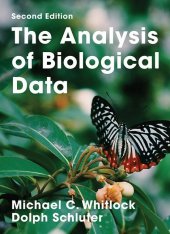 Neuerscheinungen 2014Stand: 2020-02-01 |
Schnellsuche
ISBN/Stichwort/Autor
|
Herderstraße 10
10625 Berlin
Tel.: 030 315 714 16
Fax 030 315 714 14
info@buchspektrum.de |

Dolph Schluter, Michael C. Whitlock
(Beteiligte)
The Analysis of Biological Data
2. Aufl. 2014. 235 mm
Verlag/Jahr: SPRINGER, BERLIN; SPRINGER PALGRAVE MACMILLAN 2014
ISBN: 1-319-15421-2 (1319154212)
Neue ISBN: 978-1-319-15421-9 (9781319154219)
Preis und Lieferzeit: Bitte klicken
This second edition textbook teaches modern methods of statistics through the use of fascinating biological and medical case studies. The clear and engaging writing and practical perspective allows students to understand the analytical process behind biological data. Through the use of real world biological examples, biologists and health professionals can learn statistics in an essential manner.
Authors Whitlock and Schulter have over 40 years´ experience between the two of them and therefore able to understand that students learn best through interesting examples and not overcomplicated formulas. This edition includes several unusual features that they have discovered to be helpful for effectively reaching their readers.
PART 1. INTRODUCTION TO STATISTICS.- 1. Statistics and samples .- INTERLEAF 1 Biology and the history of statistics .- 2. Displaying data.- 3. Describing data .- 4. Estimating with uncertainty .- INTERLEAF 2 Pseudoreplication .- 5. Probability .- 6. Hypothesis testing .- INTERLEAF 3 Why statistical significance is not the same as biological importance .- PART 2. PROPORTIONS AND FREQUENCIES
7. Analyzing proportions .- INTERLEAF 4 Correlation does not require causation .- 8. Fitting probability models to frequency data .- INTERLEAF 5 Making a plan .- 9. Contingency analysis: associations between categorical variables .- PART 3. COMPARING NUMERICAL VALUES.- 10. The normal distribution .- INTERLEAF 6 Controls in medical studies .- 11. Inference for a normal population .- 12. Comparing two means .- INTERLEAF 7 Which test should I use? .- 13. Handling violations of assumptions.- 14. Designing experiments .- INTERLEAF 8 Data dredging.- 15. Comparing means of more than two groups .- INTERLEAF 9 Experimental and statistical mistakes .- PART 4. REGRESSION AND CORRELATION.- 16. Correlation between numerical variables .- INTERLEAF 10 Publication bias
17. Regression .- INTERLEAF 11 Using species as data points .- PART 5. MODERN STATISTICAL METHODS.- 18. Multiple explanatory variables .- 19. Computer-intensive methods .- 20. Likelihood .- 21. Meta-analysis: combining information from multiple studies.- Answers to practice problems .- Literature cited.- Statistical tables .- Photo credits .- Index.
Michael Whitlock is an evolutionary biologist and population geneticist. He is a professor of zoology at the University of British Columbia, where he has taught statistics to biology students since 1995. Whitlock is known for his work on the spatial structure of biological populations, genetic drift, and the genetics of adaptation. He has worked with fungus beetles, rhinos, and fruit flies; mathematical theory; and statistical genetics. He is a fellow of the American Academy of Arts and Sciences and a fellow of the American Association for the Advancement of Science. He is also the former editor-in-chief of The American Naturalist.
Dolph Schluter is professor and Canada Research Chair in the zoology department and Biodiversity Research Center at the University of British Columbia. He currently teaches evolutionary ecology as well as a graduate course in biological data analysis. He is a fellow of the Royal Society of London and the Royal Society of Canada and is a Foreign Member of the American Academy of Arts and Sciences. He has received multiple honors including the Guggenheim Fellowship, The Sewall Wright Award from the American Society of Naturalists, the Killam Fellowship from the Canada Council, and the Darwin-Wallace Medal from the Linnean Society of London.


